The Development of Human rights PDF
VerifiedAdded on 2021/09/16
|9
|2449
|89
AI Summary
Contribute Materials
Your contribution can guide someone’s learning journey. Share your
documents today.
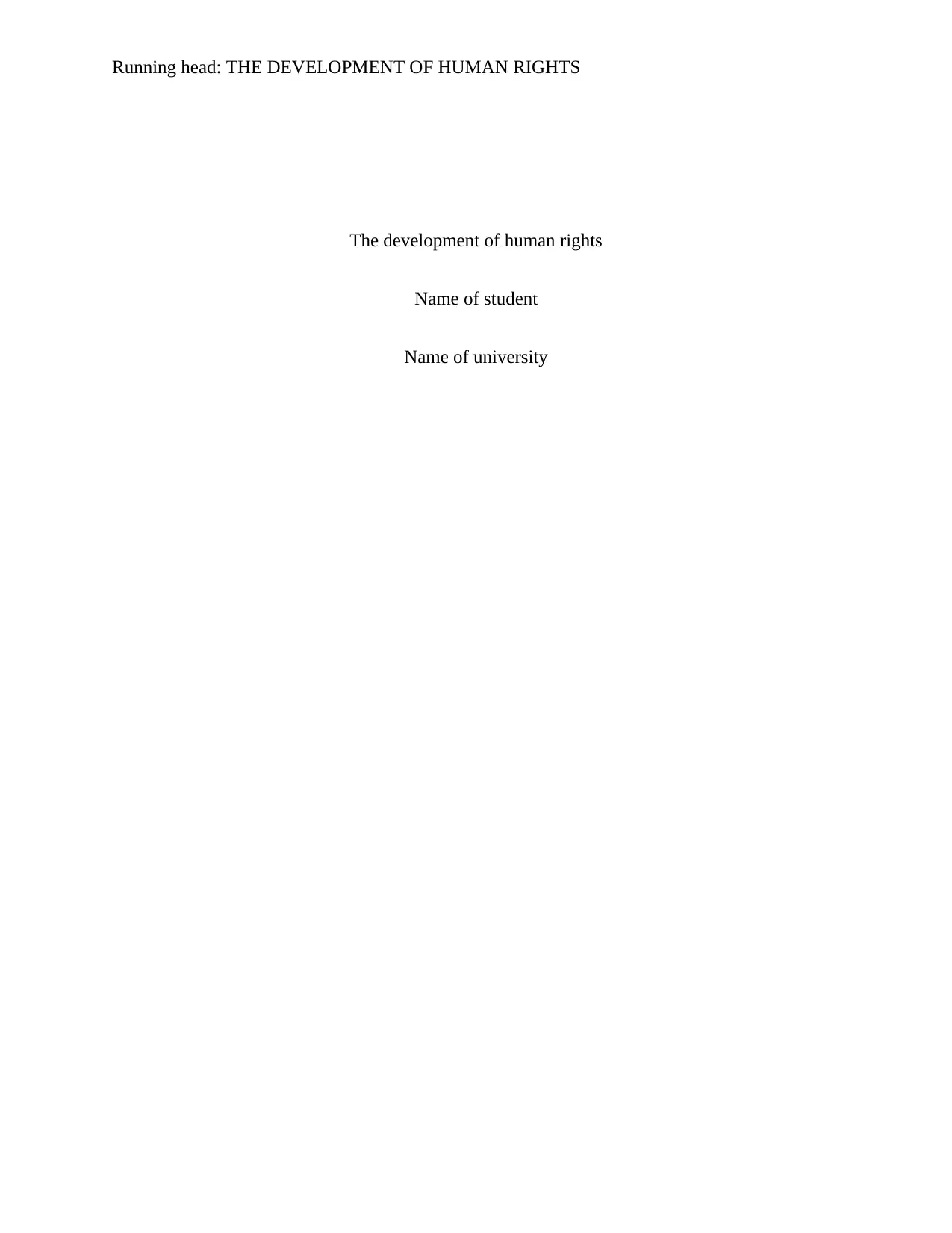
Running head: THE DEVELOPMENT OF HUMAN RIGHTS
The development of human rights
Name of student
Name of university
The development of human rights
Name of student
Name of university
Secure Best Marks with AI Grader
Need help grading? Try our AI Grader for instant feedback on your assignments.
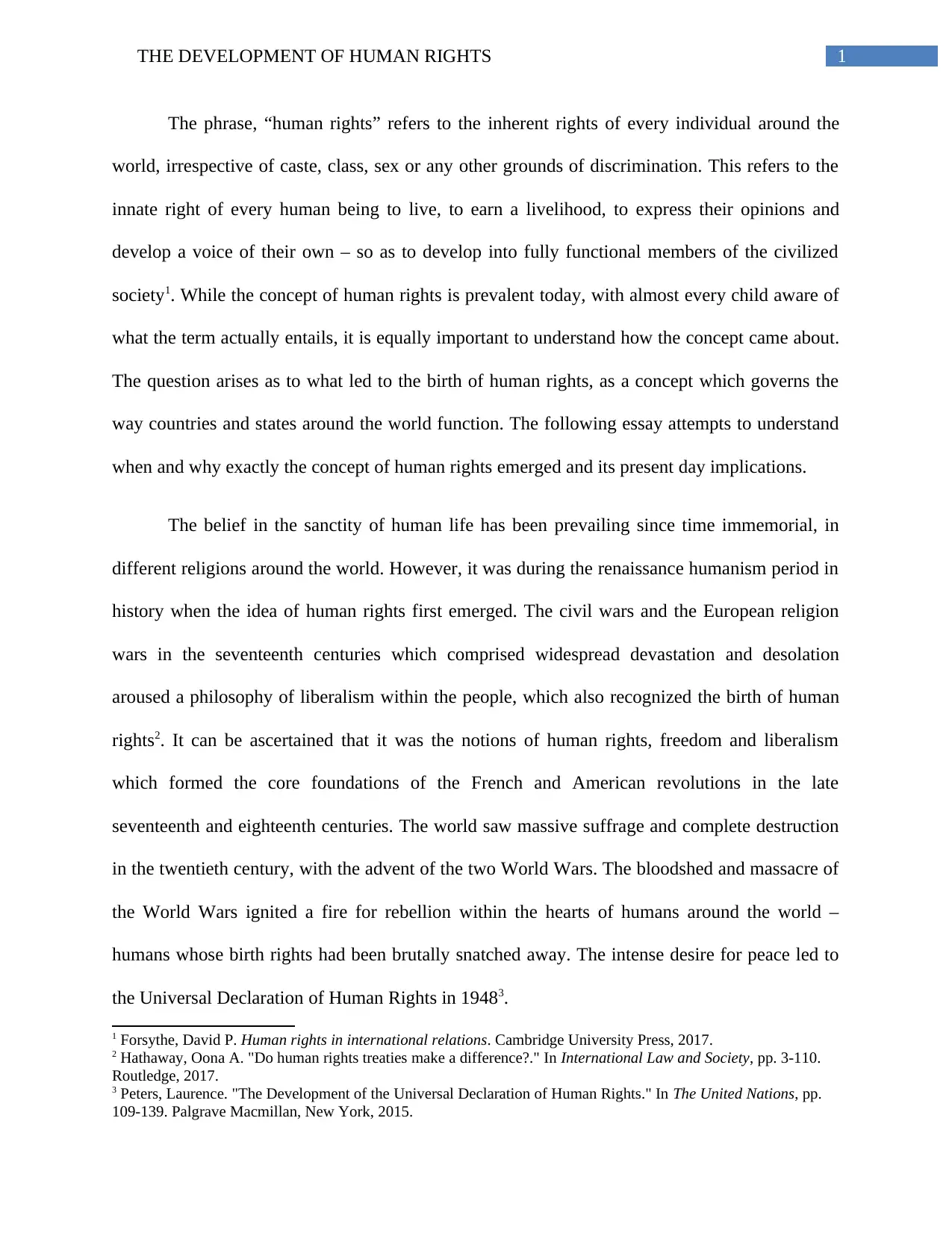
1THE DEVELOPMENT OF HUMAN RIGHTS
The phrase, “human rights” refers to the inherent rights of every individual around the
world, irrespective of caste, class, sex or any other grounds of discrimination. This refers to the
innate right of every human being to live, to earn a livelihood, to express their opinions and
develop a voice of their own – so as to develop into fully functional members of the civilized
society1. While the concept of human rights is prevalent today, with almost every child aware of
what the term actually entails, it is equally important to understand how the concept came about.
The question arises as to what led to the birth of human rights, as a concept which governs the
way countries and states around the world function. The following essay attempts to understand
when and why exactly the concept of human rights emerged and its present day implications.
The belief in the sanctity of human life has been prevailing since time immemorial, in
different religions around the world. However, it was during the renaissance humanism period in
history when the idea of human rights first emerged. The civil wars and the European religion
wars in the seventeenth centuries which comprised widespread devastation and desolation
aroused a philosophy of liberalism within the people, which also recognized the birth of human
rights2. It can be ascertained that it was the notions of human rights, freedom and liberalism
which formed the core foundations of the French and American revolutions in the late
seventeenth and eighteenth centuries. The world saw massive suffrage and complete destruction
in the twentieth century, with the advent of the two World Wars. The bloodshed and massacre of
the World Wars ignited a fire for rebellion within the hearts of humans around the world –
humans whose birth rights had been brutally snatched away. The intense desire for peace led to
the Universal Declaration of Human Rights in 19483.
1 Forsythe, David P. Human rights in international relations. Cambridge University Press, 2017.
2 Hathaway, Oona A. "Do human rights treaties make a difference?." In International Law and Society, pp. 3-110.
Routledge, 2017.
3 Peters, Laurence. "The Development of the Universal Declaration of Human Rights." In The United Nations, pp.
109-139. Palgrave Macmillan, New York, 2015.
The phrase, “human rights” refers to the inherent rights of every individual around the
world, irrespective of caste, class, sex or any other grounds of discrimination. This refers to the
innate right of every human being to live, to earn a livelihood, to express their opinions and
develop a voice of their own – so as to develop into fully functional members of the civilized
society1. While the concept of human rights is prevalent today, with almost every child aware of
what the term actually entails, it is equally important to understand how the concept came about.
The question arises as to what led to the birth of human rights, as a concept which governs the
way countries and states around the world function. The following essay attempts to understand
when and why exactly the concept of human rights emerged and its present day implications.
The belief in the sanctity of human life has been prevailing since time immemorial, in
different religions around the world. However, it was during the renaissance humanism period in
history when the idea of human rights first emerged. The civil wars and the European religion
wars in the seventeenth centuries which comprised widespread devastation and desolation
aroused a philosophy of liberalism within the people, which also recognized the birth of human
rights2. It can be ascertained that it was the notions of human rights, freedom and liberalism
which formed the core foundations of the French and American revolutions in the late
seventeenth and eighteenth centuries. The world saw massive suffrage and complete destruction
in the twentieth century, with the advent of the two World Wars. The bloodshed and massacre of
the World Wars ignited a fire for rebellion within the hearts of humans around the world –
humans whose birth rights had been brutally snatched away. The intense desire for peace led to
the Universal Declaration of Human Rights in 19483.
1 Forsythe, David P. Human rights in international relations. Cambridge University Press, 2017.
2 Hathaway, Oona A. "Do human rights treaties make a difference?." In International Law and Society, pp. 3-110.
Routledge, 2017.
3 Peters, Laurence. "The Development of the Universal Declaration of Human Rights." In The United Nations, pp.
109-139. Palgrave Macmillan, New York, 2015.
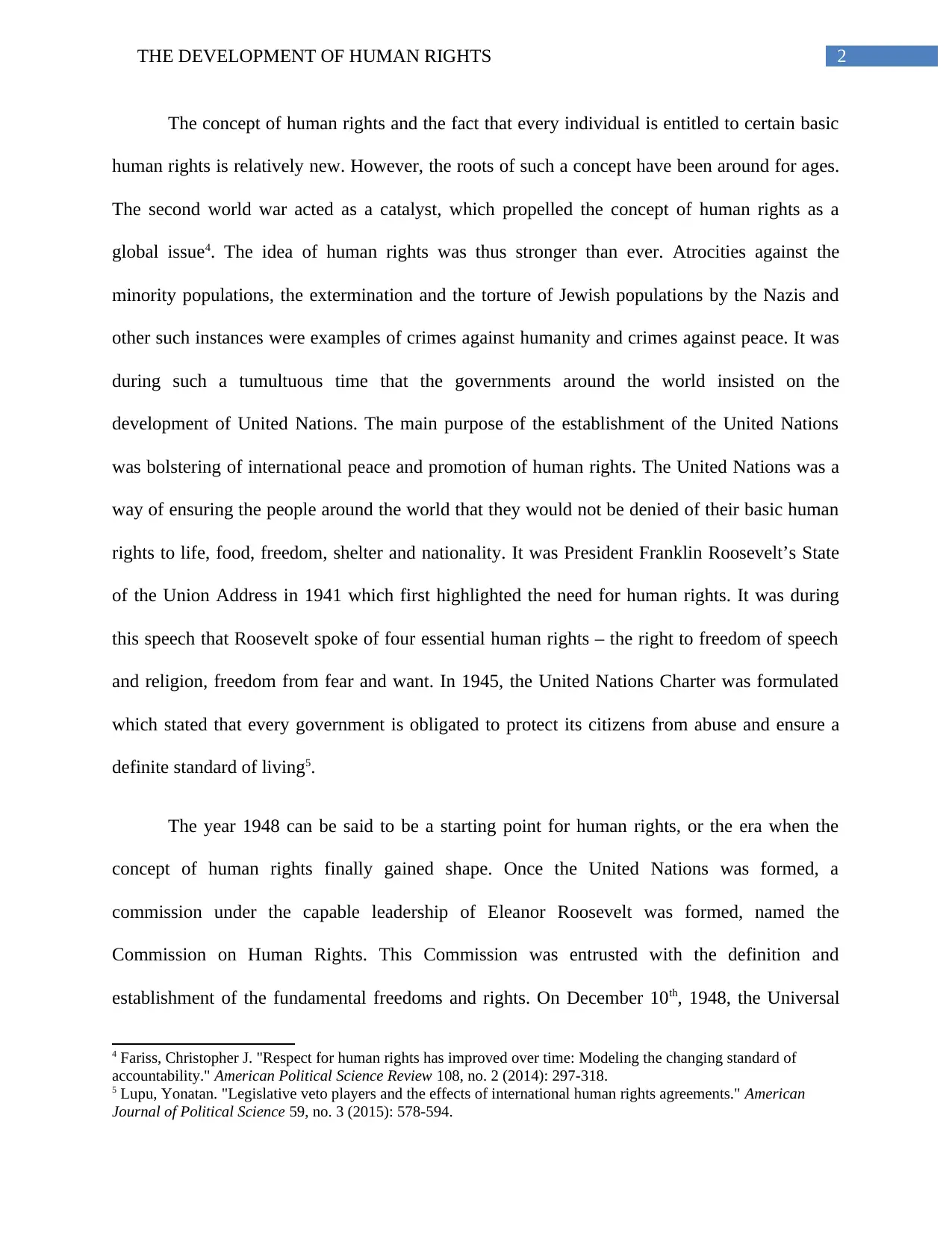
2THE DEVELOPMENT OF HUMAN RIGHTS
The concept of human rights and the fact that every individual is entitled to certain basic
human rights is relatively new. However, the roots of such a concept have been around for ages.
The second world war acted as a catalyst, which propelled the concept of human rights as a
global issue4. The idea of human rights was thus stronger than ever. Atrocities against the
minority populations, the extermination and the torture of Jewish populations by the Nazis and
other such instances were examples of crimes against humanity and crimes against peace. It was
during such a tumultuous time that the governments around the world insisted on the
development of United Nations. The main purpose of the establishment of the United Nations
was bolstering of international peace and promotion of human rights. The United Nations was a
way of ensuring the people around the world that they would not be denied of their basic human
rights to life, food, freedom, shelter and nationality. It was President Franklin Roosevelt’s State
of the Union Address in 1941 which first highlighted the need for human rights. It was during
this speech that Roosevelt spoke of four essential human rights – the right to freedom of speech
and religion, freedom from fear and want. In 1945, the United Nations Charter was formulated
which stated that every government is obligated to protect its citizens from abuse and ensure a
definite standard of living5.
The year 1948 can be said to be a starting point for human rights, or the era when the
concept of human rights finally gained shape. Once the United Nations was formed, a
commission under the capable leadership of Eleanor Roosevelt was formed, named the
Commission on Human Rights. This Commission was entrusted with the definition and
establishment of the fundamental freedoms and rights. On December 10th, 1948, the Universal
4 Fariss, Christopher J. "Respect for human rights has improved over time: Modeling the changing standard of
accountability." American Political Science Review 108, no. 2 (2014): 297-318.
5 Lupu, Yonatan. "Legislative veto players and the effects of international human rights agreements." American
Journal of Political Science 59, no. 3 (2015): 578-594.
The concept of human rights and the fact that every individual is entitled to certain basic
human rights is relatively new. However, the roots of such a concept have been around for ages.
The second world war acted as a catalyst, which propelled the concept of human rights as a
global issue4. The idea of human rights was thus stronger than ever. Atrocities against the
minority populations, the extermination and the torture of Jewish populations by the Nazis and
other such instances were examples of crimes against humanity and crimes against peace. It was
during such a tumultuous time that the governments around the world insisted on the
development of United Nations. The main purpose of the establishment of the United Nations
was bolstering of international peace and promotion of human rights. The United Nations was a
way of ensuring the people around the world that they would not be denied of their basic human
rights to life, food, freedom, shelter and nationality. It was President Franklin Roosevelt’s State
of the Union Address in 1941 which first highlighted the need for human rights. It was during
this speech that Roosevelt spoke of four essential human rights – the right to freedom of speech
and religion, freedom from fear and want. In 1945, the United Nations Charter was formulated
which stated that every government is obligated to protect its citizens from abuse and ensure a
definite standard of living5.
The year 1948 can be said to be a starting point for human rights, or the era when the
concept of human rights finally gained shape. Once the United Nations was formed, a
commission under the capable leadership of Eleanor Roosevelt was formed, named the
Commission on Human Rights. This Commission was entrusted with the definition and
establishment of the fundamental freedoms and rights. On December 10th, 1948, the Universal
4 Fariss, Christopher J. "Respect for human rights has improved over time: Modeling the changing standard of
accountability." American Political Science Review 108, no. 2 (2014): 297-318.
5 Lupu, Yonatan. "Legislative veto players and the effects of international human rights agreements." American
Journal of Political Science 59, no. 3 (2015): 578-594.
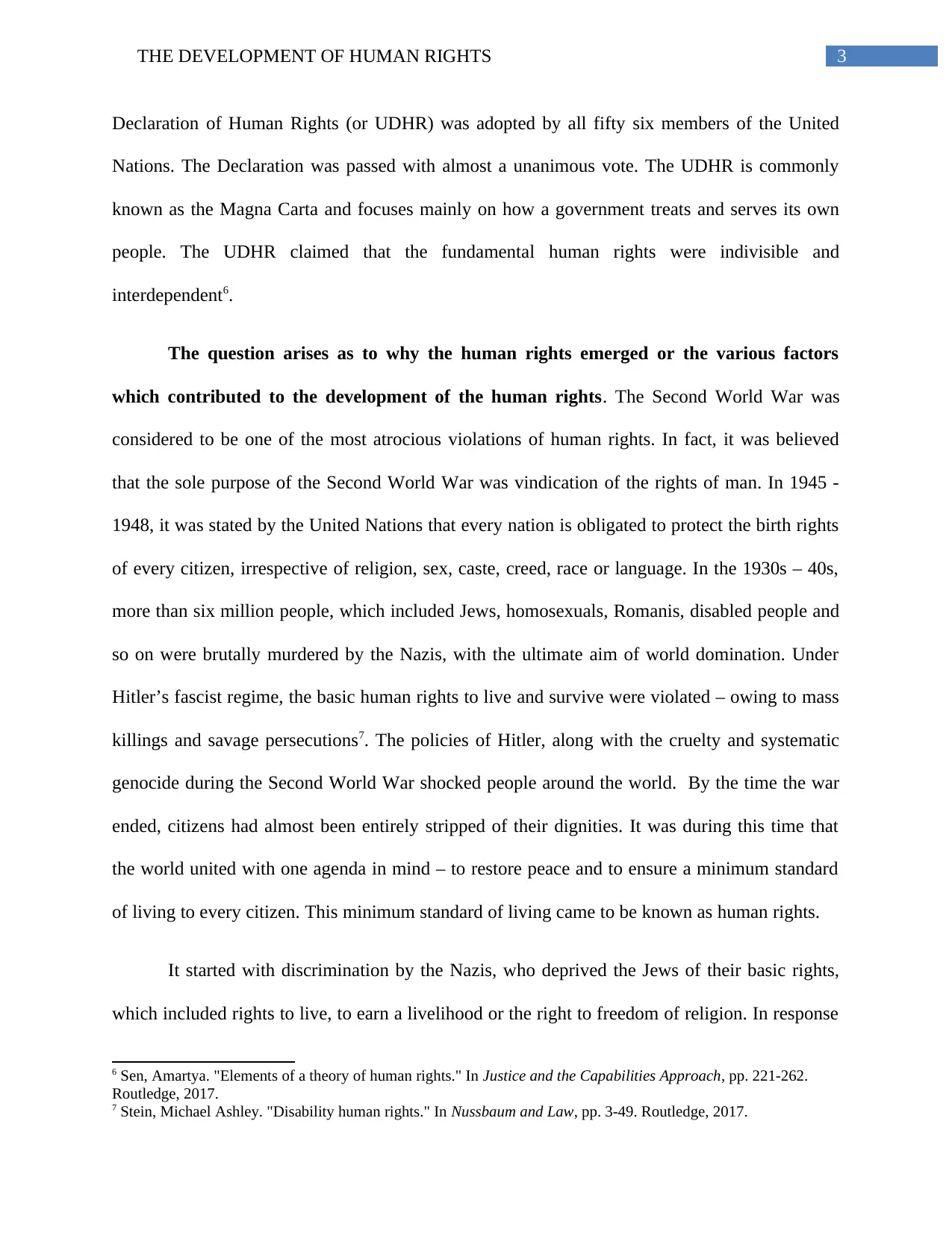
3THE DEVELOPMENT OF HUMAN RIGHTS
Declaration of Human Rights (or UDHR) was adopted by all fifty six members of the United
Nations. The Declaration was passed with almost a unanimous vote. The UDHR is commonly
known as the Magna Carta and focuses mainly on how a government treats and serves its own
people. The UDHR claimed that the fundamental human rights were indivisible and
interdependent6.
The question arises as to why the human rights emerged or the various factors
which contributed to the development of the human rights. The Second World War was
considered to be one of the most atrocious violations of human rights. In fact, it was believed
that the sole purpose of the Second World War was vindication of the rights of man. In 1945 -
1948, it was stated by the United Nations that every nation is obligated to protect the birth rights
of every citizen, irrespective of religion, sex, caste, creed, race or language. In the 1930s – 40s,
more than six million people, which included Jews, homosexuals, Romanis, disabled people and
so on were brutally murdered by the Nazis, with the ultimate aim of world domination. Under
Hitler’s fascist regime, the basic human rights to live and survive were violated – owing to mass
killings and savage persecutions7. The policies of Hitler, along with the cruelty and systematic
genocide during the Second World War shocked people around the world. By the time the war
ended, citizens had almost been entirely stripped of their dignities. It was during this time that
the world united with one agenda in mind – to restore peace and to ensure a minimum standard
of living to every citizen. This minimum standard of living came to be known as human rights.
It started with discrimination by the Nazis, who deprived the Jews of their basic rights,
which included rights to live, to earn a livelihood or the right to freedom of religion. In response
6 Sen, Amartya. "Elements of a theory of human rights." In Justice and the Capabilities Approach, pp. 221-262.
Routledge, 2017.
7 Stein, Michael Ashley. "Disability human rights." In Nussbaum and Law, pp. 3-49. Routledge, 2017.
Declaration of Human Rights (or UDHR) was adopted by all fifty six members of the United
Nations. The Declaration was passed with almost a unanimous vote. The UDHR is commonly
known as the Magna Carta and focuses mainly on how a government treats and serves its own
people. The UDHR claimed that the fundamental human rights were indivisible and
interdependent6.
The question arises as to why the human rights emerged or the various factors
which contributed to the development of the human rights. The Second World War was
considered to be one of the most atrocious violations of human rights. In fact, it was believed
that the sole purpose of the Second World War was vindication of the rights of man. In 1945 -
1948, it was stated by the United Nations that every nation is obligated to protect the birth rights
of every citizen, irrespective of religion, sex, caste, creed, race or language. In the 1930s – 40s,
more than six million people, which included Jews, homosexuals, Romanis, disabled people and
so on were brutally murdered by the Nazis, with the ultimate aim of world domination. Under
Hitler’s fascist regime, the basic human rights to live and survive were violated – owing to mass
killings and savage persecutions7. The policies of Hitler, along with the cruelty and systematic
genocide during the Second World War shocked people around the world. By the time the war
ended, citizens had almost been entirely stripped of their dignities. It was during this time that
the world united with one agenda in mind – to restore peace and to ensure a minimum standard
of living to every citizen. This minimum standard of living came to be known as human rights.
It started with discrimination by the Nazis, who deprived the Jews of their basic rights,
which included rights to live, to earn a livelihood or the right to freedom of religion. In response
6 Sen, Amartya. "Elements of a theory of human rights." In Justice and the Capabilities Approach, pp. 221-262.
Routledge, 2017.
7 Stein, Michael Ashley. "Disability human rights." In Nussbaum and Law, pp. 3-49. Routledge, 2017.
Secure Best Marks with AI Grader
Need help grading? Try our AI Grader for instant feedback on your assignments.
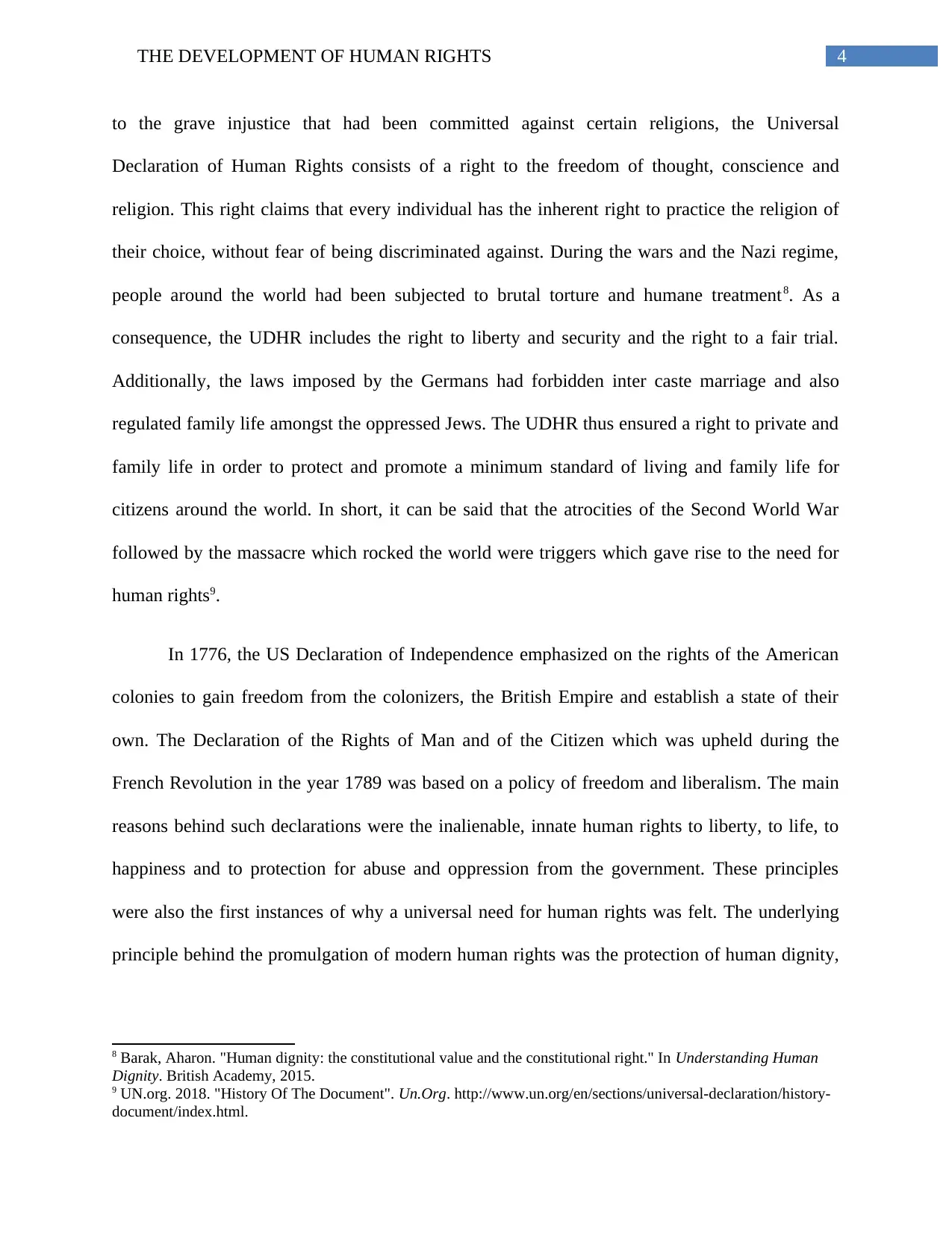
4THE DEVELOPMENT OF HUMAN RIGHTS
to the grave injustice that had been committed against certain religions, the Universal
Declaration of Human Rights consists of a right to the freedom of thought, conscience and
religion. This right claims that every individual has the inherent right to practice the religion of
their choice, without fear of being discriminated against. During the wars and the Nazi regime,
people around the world had been subjected to brutal torture and humane treatment8. As a
consequence, the UDHR includes the right to liberty and security and the right to a fair trial.
Additionally, the laws imposed by the Germans had forbidden inter caste marriage and also
regulated family life amongst the oppressed Jews. The UDHR thus ensured a right to private and
family life in order to protect and promote a minimum standard of living and family life for
citizens around the world. In short, it can be said that the atrocities of the Second World War
followed by the massacre which rocked the world were triggers which gave rise to the need for
human rights9.
In 1776, the US Declaration of Independence emphasized on the rights of the American
colonies to gain freedom from the colonizers, the British Empire and establish a state of their
own. The Declaration of the Rights of Man and of the Citizen which was upheld during the
French Revolution in the year 1789 was based on a policy of freedom and liberalism. The main
reasons behind such declarations were the inalienable, innate human rights to liberty, to life, to
happiness and to protection for abuse and oppression from the government. These principles
were also the first instances of why a universal need for human rights was felt. The underlying
principle behind the promulgation of modern human rights was the protection of human dignity,
8 Barak, Aharon. "Human dignity: the constitutional value and the constitutional right." In Understanding Human
Dignity. British Academy, 2015.
9 UN.org. 2018. "History Of The Document". Un.Org. http://www.un.org/en/sections/universal-declaration/history-
document/index.html.
to the grave injustice that had been committed against certain religions, the Universal
Declaration of Human Rights consists of a right to the freedom of thought, conscience and
religion. This right claims that every individual has the inherent right to practice the religion of
their choice, without fear of being discriminated against. During the wars and the Nazi regime,
people around the world had been subjected to brutal torture and humane treatment8. As a
consequence, the UDHR includes the right to liberty and security and the right to a fair trial.
Additionally, the laws imposed by the Germans had forbidden inter caste marriage and also
regulated family life amongst the oppressed Jews. The UDHR thus ensured a right to private and
family life in order to protect and promote a minimum standard of living and family life for
citizens around the world. In short, it can be said that the atrocities of the Second World War
followed by the massacre which rocked the world were triggers which gave rise to the need for
human rights9.
In 1776, the US Declaration of Independence emphasized on the rights of the American
colonies to gain freedom from the colonizers, the British Empire and establish a state of their
own. The Declaration of the Rights of Man and of the Citizen which was upheld during the
French Revolution in the year 1789 was based on a policy of freedom and liberalism. The main
reasons behind such declarations were the inalienable, innate human rights to liberty, to life, to
happiness and to protection for abuse and oppression from the government. These principles
were also the first instances of why a universal need for human rights was felt. The underlying
principle behind the promulgation of modern human rights was the protection of human dignity,
8 Barak, Aharon. "Human dignity: the constitutional value and the constitutional right." In Understanding Human
Dignity. British Academy, 2015.
9 UN.org. 2018. "History Of The Document". Un.Org. http://www.un.org/en/sections/universal-declaration/history-
document/index.html.
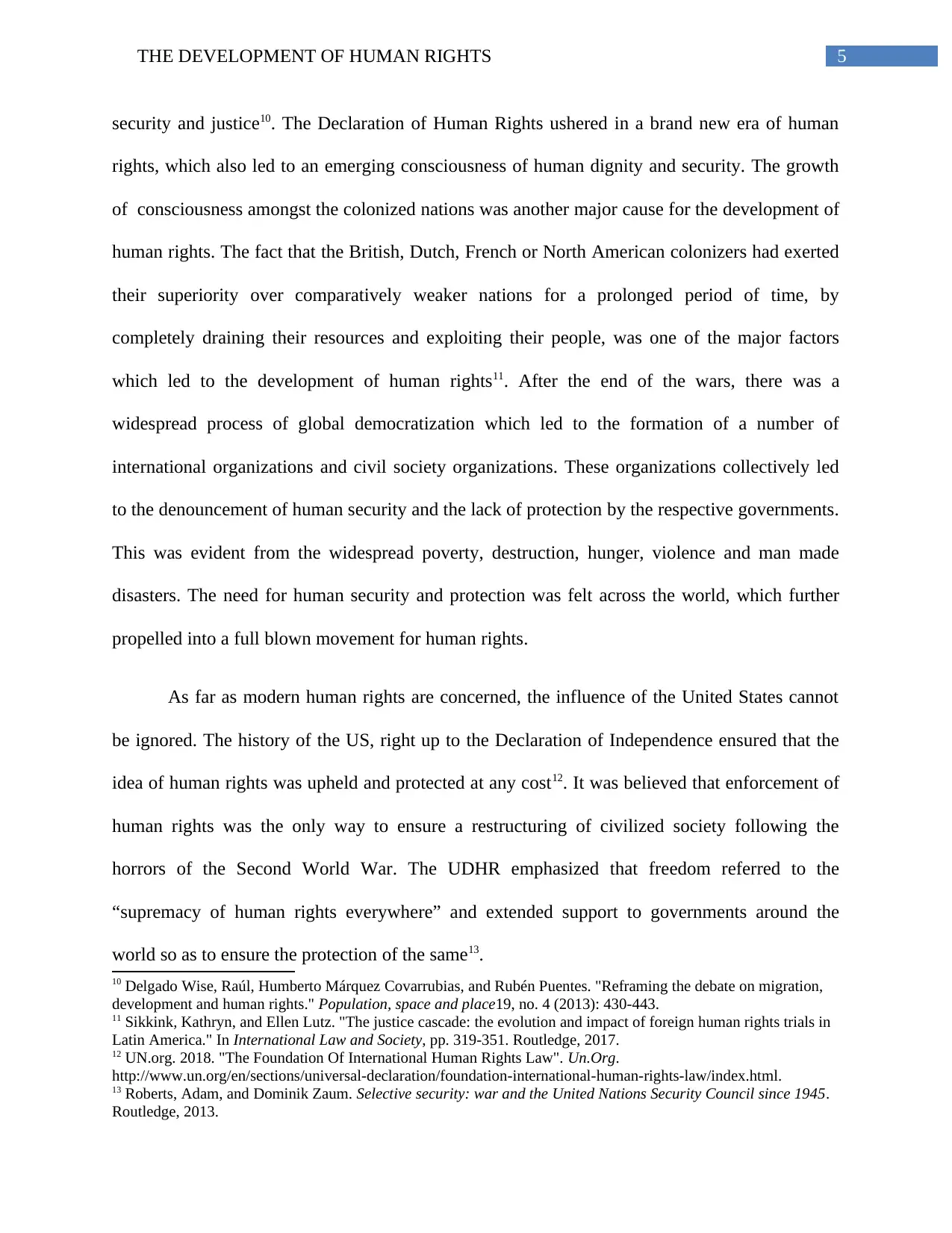
5THE DEVELOPMENT OF HUMAN RIGHTS
security and justice10. The Declaration of Human Rights ushered in a brand new era of human
rights, which also led to an emerging consciousness of human dignity and security. The growth
of consciousness amongst the colonized nations was another major cause for the development of
human rights. The fact that the British, Dutch, French or North American colonizers had exerted
their superiority over comparatively weaker nations for a prolonged period of time, by
completely draining their resources and exploiting their people, was one of the major factors
which led to the development of human rights11. After the end of the wars, there was a
widespread process of global democratization which led to the formation of a number of
international organizations and civil society organizations. These organizations collectively led
to the denouncement of human security and the lack of protection by the respective governments.
This was evident from the widespread poverty, destruction, hunger, violence and man made
disasters. The need for human security and protection was felt across the world, which further
propelled into a full blown movement for human rights.
As far as modern human rights are concerned, the influence of the United States cannot
be ignored. The history of the US, right up to the Declaration of Independence ensured that the
idea of human rights was upheld and protected at any cost12. It was believed that enforcement of
human rights was the only way to ensure a restructuring of civilized society following the
horrors of the Second World War. The UDHR emphasized that freedom referred to the
“supremacy of human rights everywhere” and extended support to governments around the
world so as to ensure the protection of the same13.
10 Delgado Wise, Raúl, Humberto Márquez Covarrubias, and Rubén Puentes. "Reframing the debate on migration,
development and human rights." Population, space and place19, no. 4 (2013): 430-443.
11 Sikkink, Kathryn, and Ellen Lutz. "The justice cascade: the evolution and impact of foreign human rights trials in
Latin America." In International Law and Society, pp. 319-351. Routledge, 2017.
12 UN.org. 2018. "The Foundation Of International Human Rights Law". Un.Org.
http://www.un.org/en/sections/universal-declaration/foundation-international-human-rights-law/index.html.
13 Roberts, Adam, and Dominik Zaum. Selective security: war and the United Nations Security Council since 1945.
Routledge, 2013.
security and justice10. The Declaration of Human Rights ushered in a brand new era of human
rights, which also led to an emerging consciousness of human dignity and security. The growth
of consciousness amongst the colonized nations was another major cause for the development of
human rights. The fact that the British, Dutch, French or North American colonizers had exerted
their superiority over comparatively weaker nations for a prolonged period of time, by
completely draining their resources and exploiting their people, was one of the major factors
which led to the development of human rights11. After the end of the wars, there was a
widespread process of global democratization which led to the formation of a number of
international organizations and civil society organizations. These organizations collectively led
to the denouncement of human security and the lack of protection by the respective governments.
This was evident from the widespread poverty, destruction, hunger, violence and man made
disasters. The need for human security and protection was felt across the world, which further
propelled into a full blown movement for human rights.
As far as modern human rights are concerned, the influence of the United States cannot
be ignored. The history of the US, right up to the Declaration of Independence ensured that the
idea of human rights was upheld and protected at any cost12. It was believed that enforcement of
human rights was the only way to ensure a restructuring of civilized society following the
horrors of the Second World War. The UDHR emphasized that freedom referred to the
“supremacy of human rights everywhere” and extended support to governments around the
world so as to ensure the protection of the same13.
10 Delgado Wise, Raúl, Humberto Márquez Covarrubias, and Rubén Puentes. "Reframing the debate on migration,
development and human rights." Population, space and place19, no. 4 (2013): 430-443.
11 Sikkink, Kathryn, and Ellen Lutz. "The justice cascade: the evolution and impact of foreign human rights trials in
Latin America." In International Law and Society, pp. 319-351. Routledge, 2017.
12 UN.org. 2018. "The Foundation Of International Human Rights Law". Un.Org.
http://www.un.org/en/sections/universal-declaration/foundation-international-human-rights-law/index.html.
13 Roberts, Adam, and Dominik Zaum. Selective security: war and the United Nations Security Council since 1945.
Routledge, 2013.
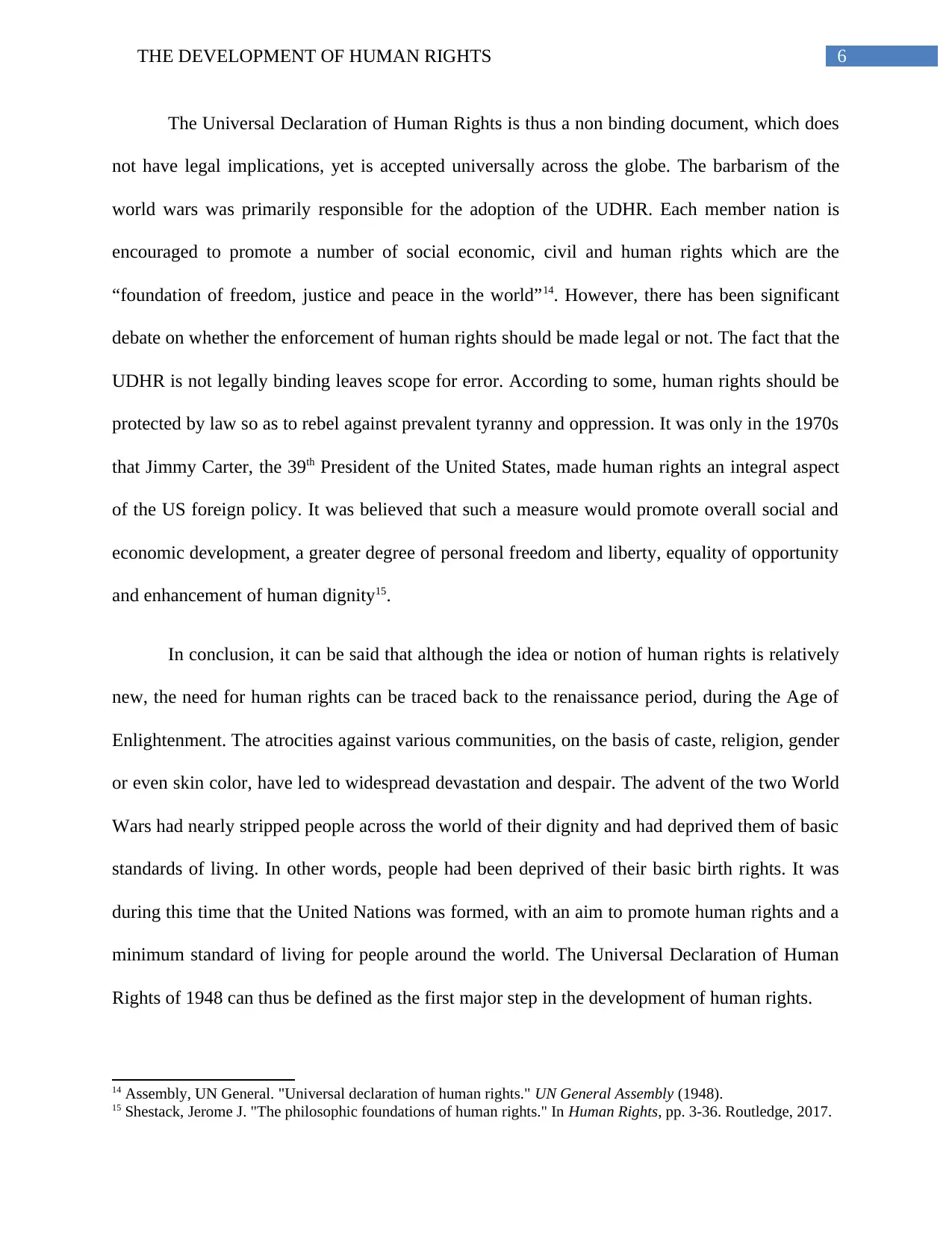
6THE DEVELOPMENT OF HUMAN RIGHTS
The Universal Declaration of Human Rights is thus a non binding document, which does
not have legal implications, yet is accepted universally across the globe. The barbarism of the
world wars was primarily responsible for the adoption of the UDHR. Each member nation is
encouraged to promote a number of social economic, civil and human rights which are the
“foundation of freedom, justice and peace in the world”14. However, there has been significant
debate on whether the enforcement of human rights should be made legal or not. The fact that the
UDHR is not legally binding leaves scope for error. According to some, human rights should be
protected by law so as to rebel against prevalent tyranny and oppression. It was only in the 1970s
that Jimmy Carter, the 39th President of the United States, made human rights an integral aspect
of the US foreign policy. It was believed that such a measure would promote overall social and
economic development, a greater degree of personal freedom and liberty, equality of opportunity
and enhancement of human dignity15.
In conclusion, it can be said that although the idea or notion of human rights is relatively
new, the need for human rights can be traced back to the renaissance period, during the Age of
Enlightenment. The atrocities against various communities, on the basis of caste, religion, gender
or even skin color, have led to widespread devastation and despair. The advent of the two World
Wars had nearly stripped people across the world of their dignity and had deprived them of basic
standards of living. In other words, people had been deprived of their basic birth rights. It was
during this time that the United Nations was formed, with an aim to promote human rights and a
minimum standard of living for people around the world. The Universal Declaration of Human
Rights of 1948 can thus be defined as the first major step in the development of human rights.
14 Assembly, UN General. "Universal declaration of human rights." UN General Assembly (1948).
15 Shestack, Jerome J. "The philosophic foundations of human rights." In Human Rights, pp. 3-36. Routledge, 2017.
The Universal Declaration of Human Rights is thus a non binding document, which does
not have legal implications, yet is accepted universally across the globe. The barbarism of the
world wars was primarily responsible for the adoption of the UDHR. Each member nation is
encouraged to promote a number of social economic, civil and human rights which are the
“foundation of freedom, justice and peace in the world”14. However, there has been significant
debate on whether the enforcement of human rights should be made legal or not. The fact that the
UDHR is not legally binding leaves scope for error. According to some, human rights should be
protected by law so as to rebel against prevalent tyranny and oppression. It was only in the 1970s
that Jimmy Carter, the 39th President of the United States, made human rights an integral aspect
of the US foreign policy. It was believed that such a measure would promote overall social and
economic development, a greater degree of personal freedom and liberty, equality of opportunity
and enhancement of human dignity15.
In conclusion, it can be said that although the idea or notion of human rights is relatively
new, the need for human rights can be traced back to the renaissance period, during the Age of
Enlightenment. The atrocities against various communities, on the basis of caste, religion, gender
or even skin color, have led to widespread devastation and despair. The advent of the two World
Wars had nearly stripped people across the world of their dignity and had deprived them of basic
standards of living. In other words, people had been deprived of their basic birth rights. It was
during this time that the United Nations was formed, with an aim to promote human rights and a
minimum standard of living for people around the world. The Universal Declaration of Human
Rights of 1948 can thus be defined as the first major step in the development of human rights.
14 Assembly, UN General. "Universal declaration of human rights." UN General Assembly (1948).
15 Shestack, Jerome J. "The philosophic foundations of human rights." In Human Rights, pp. 3-36. Routledge, 2017.
Paraphrase This Document
Need a fresh take? Get an instant paraphrase of this document with our AI Paraphraser
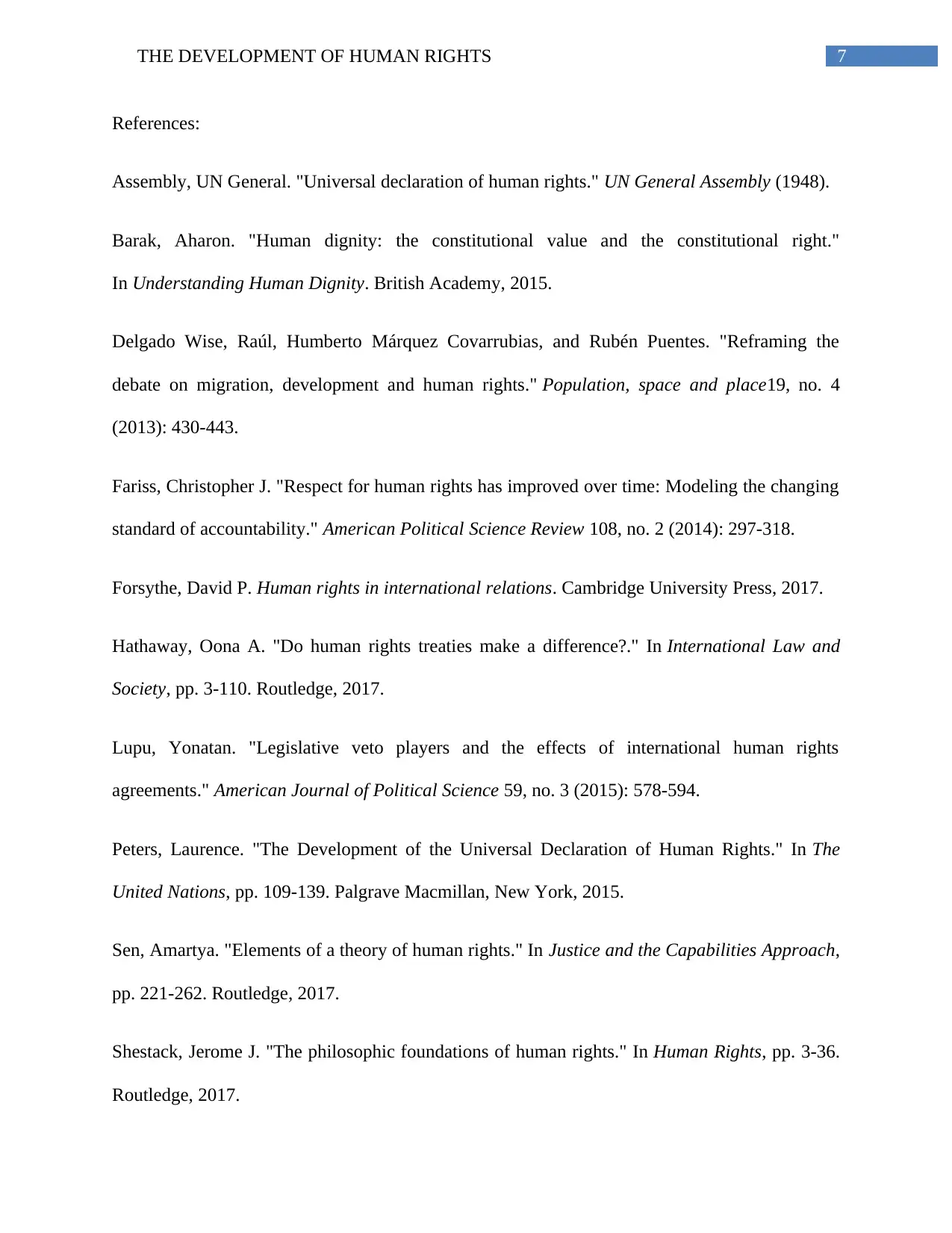
7THE DEVELOPMENT OF HUMAN RIGHTS
References:
Assembly, UN General. "Universal declaration of human rights." UN General Assembly (1948).
Barak, Aharon. "Human dignity: the constitutional value and the constitutional right."
In Understanding Human Dignity. British Academy, 2015.
Delgado Wise, Raúl, Humberto Márquez Covarrubias, and Rubén Puentes. "Reframing the
debate on migration, development and human rights." Population, space and place19, no. 4
(2013): 430-443.
Fariss, Christopher J. "Respect for human rights has improved over time: Modeling the changing
standard of accountability." American Political Science Review 108, no. 2 (2014): 297-318.
Forsythe, David P. Human rights in international relations. Cambridge University Press, 2017.
Hathaway, Oona A. "Do human rights treaties make a difference?." In International Law and
Society, pp. 3-110. Routledge, 2017.
Lupu, Yonatan. "Legislative veto players and the effects of international human rights
agreements." American Journal of Political Science 59, no. 3 (2015): 578-594.
Peters, Laurence. "The Development of the Universal Declaration of Human Rights." In The
United Nations, pp. 109-139. Palgrave Macmillan, New York, 2015.
Sen, Amartya. "Elements of a theory of human rights." In Justice and the Capabilities Approach,
pp. 221-262. Routledge, 2017.
Shestack, Jerome J. "The philosophic foundations of human rights." In Human Rights, pp. 3-36.
Routledge, 2017.
References:
Assembly, UN General. "Universal declaration of human rights." UN General Assembly (1948).
Barak, Aharon. "Human dignity: the constitutional value and the constitutional right."
In Understanding Human Dignity. British Academy, 2015.
Delgado Wise, Raúl, Humberto Márquez Covarrubias, and Rubén Puentes. "Reframing the
debate on migration, development and human rights." Population, space and place19, no. 4
(2013): 430-443.
Fariss, Christopher J. "Respect for human rights has improved over time: Modeling the changing
standard of accountability." American Political Science Review 108, no. 2 (2014): 297-318.
Forsythe, David P. Human rights in international relations. Cambridge University Press, 2017.
Hathaway, Oona A. "Do human rights treaties make a difference?." In International Law and
Society, pp. 3-110. Routledge, 2017.
Lupu, Yonatan. "Legislative veto players and the effects of international human rights
agreements." American Journal of Political Science 59, no. 3 (2015): 578-594.
Peters, Laurence. "The Development of the Universal Declaration of Human Rights." In The
United Nations, pp. 109-139. Palgrave Macmillan, New York, 2015.
Sen, Amartya. "Elements of a theory of human rights." In Justice and the Capabilities Approach,
pp. 221-262. Routledge, 2017.
Shestack, Jerome J. "The philosophic foundations of human rights." In Human Rights, pp. 3-36.
Routledge, 2017.
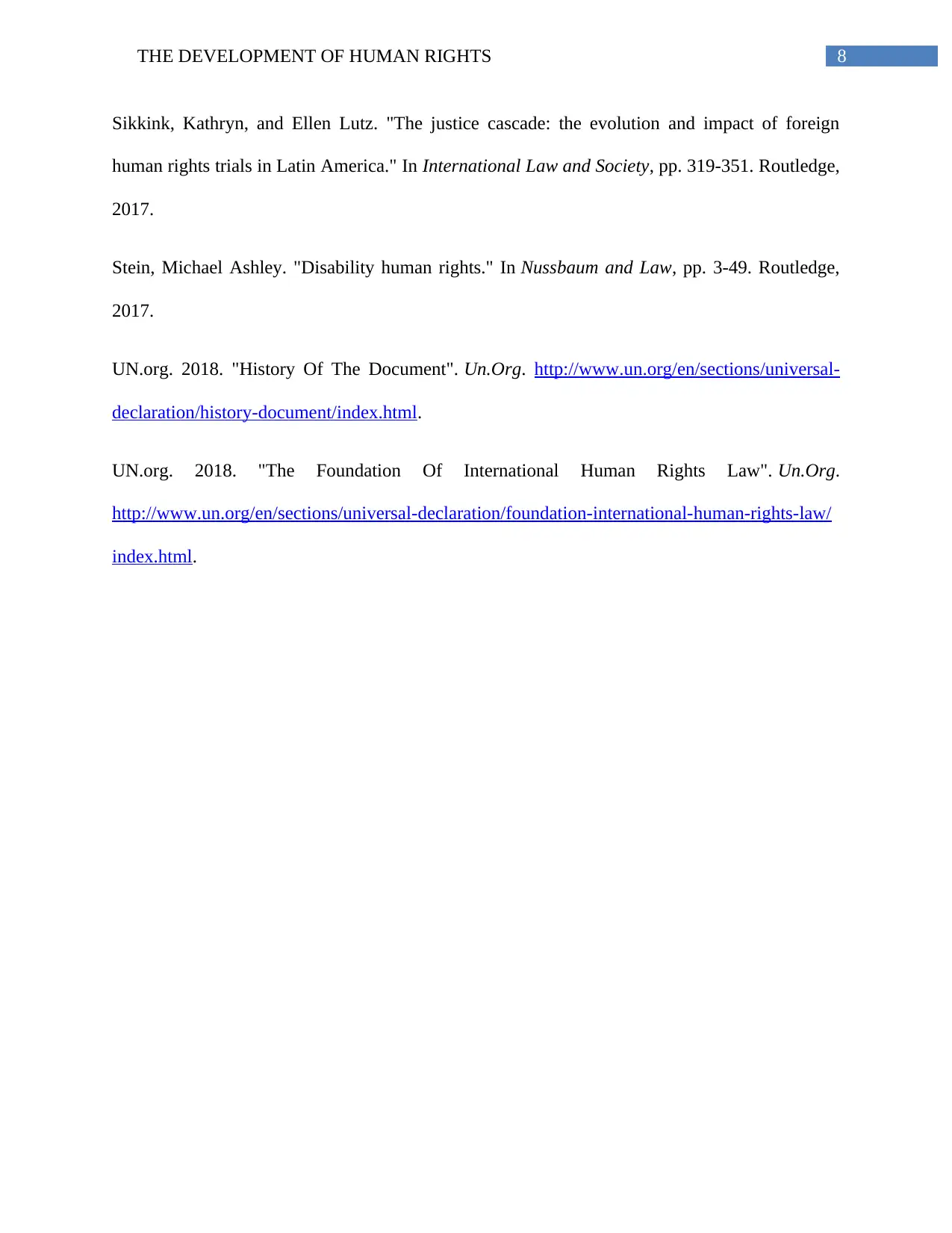
8THE DEVELOPMENT OF HUMAN RIGHTS
Sikkink, Kathryn, and Ellen Lutz. "The justice cascade: the evolution and impact of foreign
human rights trials in Latin America." In International Law and Society, pp. 319-351. Routledge,
2017.
Stein, Michael Ashley. "Disability human rights." In Nussbaum and Law, pp. 3-49. Routledge,
2017.
UN.org. 2018. "History Of The Document". Un.Org. http://www.un.org/en/sections/universal-
declaration/history-document/index.html.
UN.org. 2018. "The Foundation Of International Human Rights Law". Un.Org.
http://www.un.org/en/sections/universal-declaration/foundation-international-human-rights-law/
index.html.
Sikkink, Kathryn, and Ellen Lutz. "The justice cascade: the evolution and impact of foreign
human rights trials in Latin America." In International Law and Society, pp. 319-351. Routledge,
2017.
Stein, Michael Ashley. "Disability human rights." In Nussbaum and Law, pp. 3-49. Routledge,
2017.
UN.org. 2018. "History Of The Document". Un.Org. http://www.un.org/en/sections/universal-
declaration/history-document/index.html.
UN.org. 2018. "The Foundation Of International Human Rights Law". Un.Org.
http://www.un.org/en/sections/universal-declaration/foundation-international-human-rights-law/
index.html.
1 out of 9
Related Documents
Your All-in-One AI-Powered Toolkit for Academic Success.
+13062052269
info@desklib.com
Available 24*7 on WhatsApp / Email
![[object Object]](/_next/static/media/star-bottom.7253800d.svg)
Unlock your academic potential
© 2024 | Zucol Services PVT LTD | All rights reserved.




